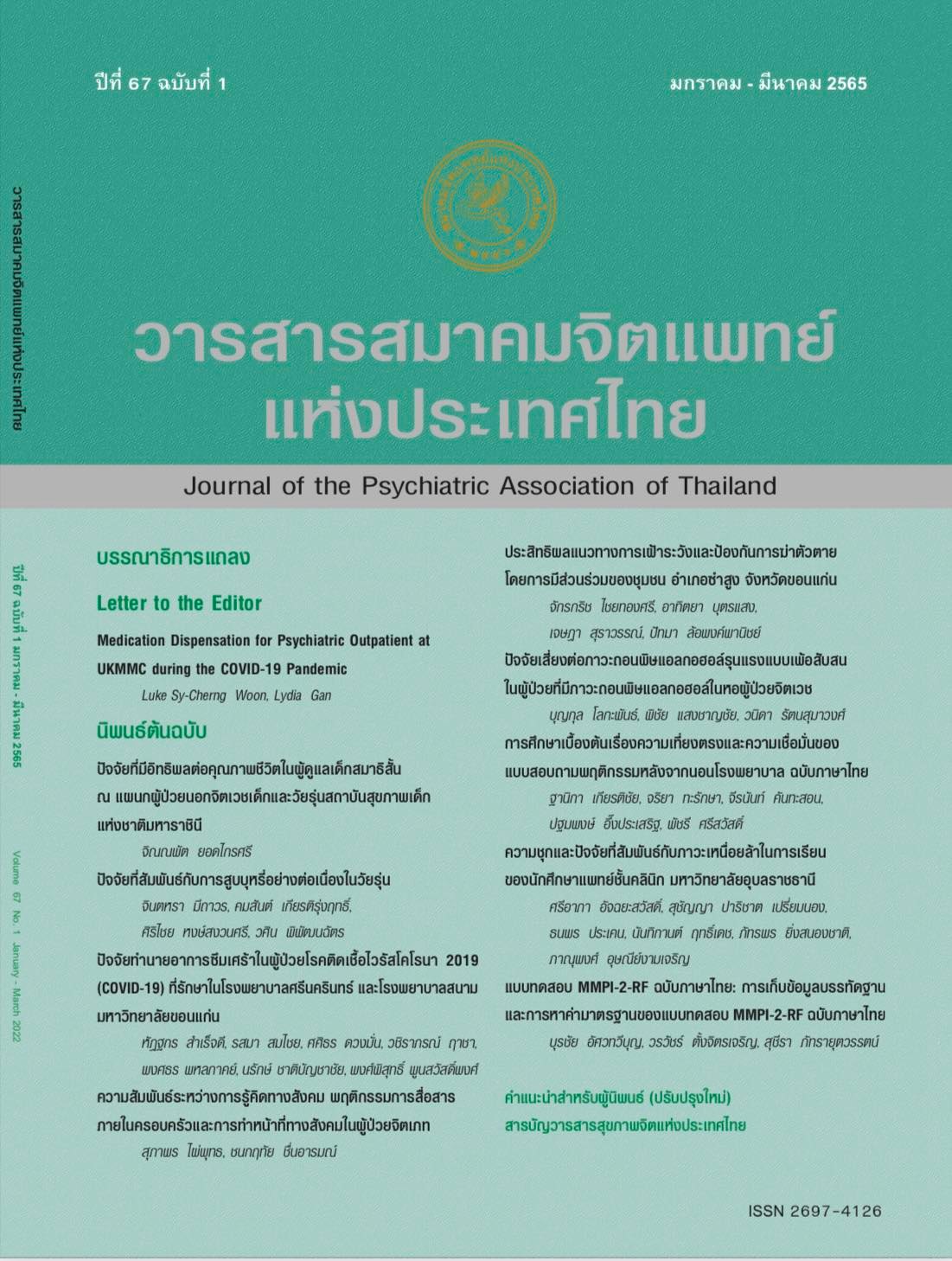The Effectiveness of Suicide Surveillance and Prevention Guidelines with the Community Participation in Sam Sung District, Khon Kaen Province
Main Article Content
Abstract
ABSTRACT
Objective: To study the effectiveness of suicide surveillance and prevention guidelines with the community participation in Sam Sung District, Khon Kaen Province
Method: This was a quasi-experimental pre-test and post-test studies research design. Data were collected from September 1 - December 31, 2020. The sample groups were purposive sampling include the suicidal risk groups, which divided into the control and experimental group, 30 people for each group, Sam Sung health service network, suicide risk families and buddy families. The research tools consisted of 1) teaching plans, 2) assessment of knowledge, attitudes and surveillance behaviors of suicide prevention 3) the 2-questions depression screening form, the 9-questions depression screening form, and the 8-questions suicidal ideation form (8Q) from the Department of Mental Health, Ministry of Health. The Index of item objective congruence was .092 and Cronbach's alpha coefficient was 0.863. Data were analyzed by descriptive statistics and inferential statistics as paired t-test and independent sample t-test statistics.
Results: The mean score of knowledge in Sam Sung health service network group after training was statistically significantly higher than before training at .05 (p-value .000). The mean score of knowledge, attitude, and behavior of suicide prevention surveillance in suicide risk families and buddy families’ groups after training were statistically significantly higher than before training at .05 (p-value .000, .002, and .000 respectively) The experimental suicidal risk group had a 9-question depression screening mean score significantly lower than the control group at .05 (p-value .000).
Conclusion: Provide knowledge and skills of suicide prevention surveillance and transfer to the families and communities together with the development of mental health knowledge in suicide risk groups can decrease depression and the idea of suicide effectively.
Article Details

This work is licensed under a Creative Commons Attribution-NonCommercial-NoDerivatives 4.0 International License.
Articles submitted for consideration must not have been previously published or accepted for publication in any other journal, and must not be under review by any other journal.
References
เอกสารอ้างอิง
World Health Organization. World Health Statistics 2019: Monitoring health for the SDGs. Geneva: World Health Organization; 2019.
National suicide prevention center. Success rate of suicide per 100,000 populations [Internet]. 2021. Available from: https://suicide.dmh.go.th/report/suicide/stat_prov.asp
National suicide prevention center. Suicide rate Khon Kaen Province during the year 2017 - 2019 [Internet]. 2021. Available from: https://suicide.dmh.go.th/report/suicide/s_stat.
Klonsky ED, May AM. The Three-Step Theory (3ST): A New Theory of Suicide Rooted in the “Ideation-to-Action” Framework. Int J Cogn Ther. 2015;8(2):114–29.
Choochom O. Quasi – Experimental Research. The Journal of Behavioral Science. 2009;15(1):1–15.
Sukamonson S. Effect size: Practical significance in research. Pasaa Paritat Journal. 2010; 25:26–37.
Thonghima T, Moolsart S and Thomyangkoon P. The Effectiveness of a Suicide Prevention Program in Elderly with Depression in a Community. Journal of Nursing, Public Health, and Education. 2019;20(2):105–18.
Cohen J. Statistical Power Analysis for the Behavioral Sciences [Internet]. second. New York: Lawrence Erlbaum; 1988 [cited 2018 Nov 4]. Available from: http://www.utstat.toronto.edu/~brunner/oldclass/378f16/readings/CohenPower.pdf
Pasunon P. Sample Size Determination from Krejcie and Morgan (1970) Approach in Quantitative Research. The Journal of Faculty of Applied Arts. 2014;7(2):112–25.
Penglia Y, Tippunya S, Puksorn K, Likasitdamrongkul W, Thanee S, and Luprasong S. Application of community participatory programs for suicide prevention: a case study at Jarim sub-district, Tha-Pla district, Uttaradit province. Journal of Mental Health of Thailand. 2018;26(3):186–96.
Junsam S, Thongkhamrod R, and Sarakan K. The Development of a Community Participatory Model in Preventing Suicide of Yasothon Province. In: The 8th STOU National Research Conference Sukhothai Thammathirat Open University. Nonthaburi; 2018. p. 405–12.
Allen J, Mohatt G, Ching C, Fok T, Henry D. International Journal of Circumpolar Health Suicide prevention as a community development process: understanding circumpolar youth suicide prevention through community level outcomes. Circumpolar Heal [Internet]. 2009 [cited 2021 Jun 23]; 68:274–91. Available from: https://www.tandfonline.com/action/journalInformation?journalCode=zich20
Piyaphan Y, and Samad W. Epidemiology of Suicide in Phuket in Fiscal Year 2007. North-Eastern Primary Health Care Journal. 2008;22(6):135–40.
Aiamsaart N, and Thaweeses P. Epidemiology Study of Suicidal Attempt and Completed Suicide Patients at Phra Phutthabat Hospital. Department of health Service Support Journal. 2020;16(3):23–30.
Charoensri H, and Khiewyoo J. Suicidal Risk Prevalence and Factors Related to Suicidal Risk Among People in Ban Tak District, Tak Province. KKU research journal (Graduate study). 2560;17(3):77–93.
Wright PP, Thorpe CW. Triple Threat Among the Elderly: Depression, Suicide Risk, and Handguns. J Emerg Nurs. 2016;42(1):14–8.
Chidmongkol R, Mueannadon R, Kaewma S, and Riabporn V. Depression and Mental Health Literacy in Adolescents. Journal of Nursing, Public Health, and Education. 2020;21(2):40–7.


